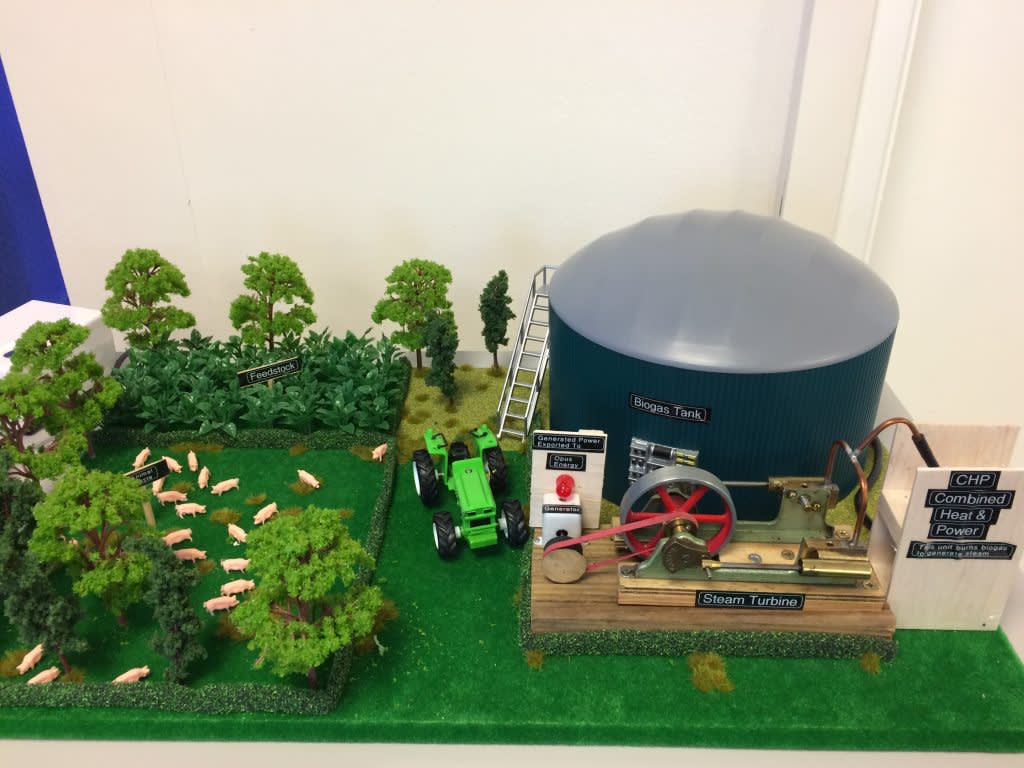The illustrated step-by-step guide to anaerobic digestion
11th May 2017
Would you recognise an anaerobic digestion plant if you saw one?
Shaun Heasman, Renewables Specialist at Opus Energy, knows them inside out – and can prove it. His miniature model making – scroll down to see his detailed work – inspired us to take a closer look at what actually happens inside one of these machines.

The process of using anaerobic digestion (AD) to produce renewable energy as we know it is a fairly modern phenomenon, with the first recognised unit being built in England in 1895. However, there is anecdotal evidence that biogas produced by anaerobic digestion was used to heat public baths in the 10th and 16th centuries across the Assyrian and Persian empires of the time, according to a publication by Pennsylvania State University.
Fast forward to modern times and AD is mainly used by farmers in the UK, as Shaun told us in his AD Q&A. It’s also being innovatively utilised by large-scale power stations that convert wood pellets into power.
Here’s exactly what it is and how it works.
What is anaerobic digestion?
In simple terms, anaerobic digestion is the breakdown of organic materials into gases – methane and carbon dioxide –with some water as a by-product. Methane is a flammable gas which can be used to produce heat and electricity.

The organic matter is broken down by microorganisms which are intolerant to oxygen; as a result, the process takes place in airtight containers. (The term aerobic indicates the need for oxygen, while processes which do not require oxygen are anaerobic).
These gases are then used as fuel, either for grid resources such as heat and electricity generation, or as biofuels for transport. Before we get there, however, there are several steps in the anaerobic digestion process.
Step one: Removing contaminants
Firstly, the organic fuel needs to be screened for contaminants. The fuel used in anaerobic digestion can be any sort of biodegradable materials; food and plant waste, as well as crops, slurries and sewage are all used.

Step two: Treating the fuel
Once screened, the fuel needs to be treated to ensure a smooth consistency; this is because many AD units are fed by continuous flow for cost effectiveness.
Once screened and treated as necessary, the fuel is fed into a digestion unit for breakdown by microorganisms.
Step three: Into the plant
Digestion units are either Mesophilic or Thermophilic; these terms refer to the temperature range within which the microorganisms work best.
Mesophilic units operate at between 20-45°C, with an optimal temperature of 37°C. These are more common, as they are cheaper to build and maintain because of their lower operational temperature.
Thermophilic units operate at a higher temperature, typically 50-60°C, but sometimes higher.

Step four: The different stages of breakdown
The breakdown of the organic material begins here, and involves four stages of chemical processes which convert the matter into useable biogases:
1. Hydrolysis
The first stage sees the breakdown of complex matter, such as carbohydrates and proteins, broken down into sugars and amino acids. These are normally long-chain chemical compounds, but Hydrolysis breaks them down into single molecules.
2. Acidogenesis
In the second stage, microorganisms break down the single molecules of sugar and amino acids even further into ethanol and fatty acids, as well as producing carbon dioxide and hydrogen sulphide as by-products.
3. Acetogenesis
In the third stage, the ethanol and fatty acids are converted into hydrogen, carbon dioxide and acetic acid.
4. Methanogenesis
In the fourth and final stage, microorganisms convert the remaining hydrogen and acetic acid into methane and more carbon dioxide.
At the end of the process, we have our methane biogas. As well as producing biogas which can be supplied to the grid or converted into biofuel, anaerobic digestion also provides digestate, a nutrient-rich fertiliser, as a by-product of the process.
Related articles

Anaerobic digestion: What makes this renewable energy source so great?
With the UK’s first ever ‘Bio-Bus’ now on the streets, it’s about time that we got to know a little bit more about the...

Opus Energy: our commitment to sustainability and our work in our communities
At Opus Energy, we’re passionate about sustainability. As part of Drax, we’re committed to ensuring a zero-carbon, lower-cost energy future. It’s why, last year,...

Our UK renewable power generation, at a glance
Opus Energy is committed to sustainability – last year, 90% of the energy supplied to our customers came from renewable sources. We don’t just...